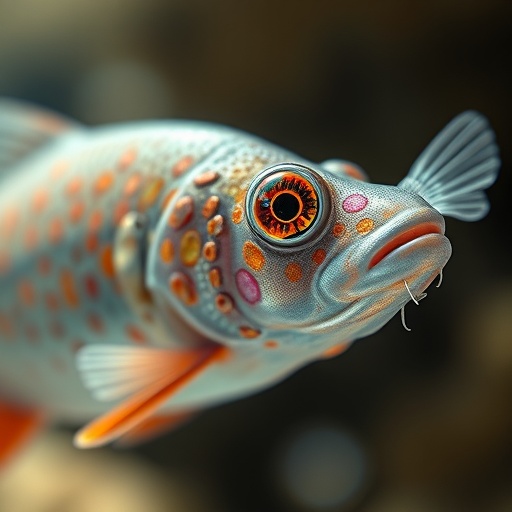In the shadowy recesses of subterranean waters across the eastern United States dwell amblyopsid cavefishes—creatures marked by their diminutive size, lack of pigmentation, and absence of functional eyes. These enigmatic fishes have long captivated biologists and evolutionary scientists due to their unique adaptations to life in perpetual darkness. A groundbreaking study conducted by researchers at Yale University has now unveiled new insights into the evolutionary history of these cave dwellers, simultaneously establishing a novel genetic method for dating the ancient caves themselves.
Traditionally, determining the age of subterranean ecosystems has been a persistent challenge for geologists and biologists alike. Standard geochronological cave-dating methods, such as isotope analysis involving cosmogenic nuclides produced by cosmic rays, typically cap their resolution at around three to five million years. This upper bound leaves many older ecosystems shrouded in mystery. However, Yale scientists have taken a transformative approach by leveraging evolutionary genomics, focusing specifically on the genomes of all known amblyopsid species to chart their independent journeys into the darkness.
The team’s genomic analysis revealed a remarkable case of convergent evolution. Despite their morphological similarities—ranging from elongated bodies and flattened skulls to the severe reduction or loss of pelvic fins—it became clear that the various amblyopsid cavefish species invaded cave systems independently. Each lineage, through distinct genetic pathways, convergently evolved traits such as eye regression and loss of pigmentation. This parallel adaptation underscores the powerful selective pressures imposed by subterranean environments and suggests a repeated evolutionary response to the absence of light.
Central to the study was a detailed examination of 88 vision-related genes across the cavefishes’ genomes. The researchers identified multiple, lineage-specific mutations disrupting the functionality of genes crucial for eyesight. Such mutation patterns indicated that eye degeneration didn’t stem from a single ancestral cave invasion followed by diversification but rather from multiple, separate colonization events. These independent genetic trajectories gave rise to the characteristic loss-of-vision phenotype, highlighting the complex interplay between the environment and genomic evolution.
Crucially, these genetic alterations also provided a novel “mutational clock”. By estimating the number of generations since functional vision genes began degenerating in each lineage, the scientists calculated minimum ages for when these fishes started adapting to cave life. For the oldest species studied—the Ozark cavefish (Troglichthys rosae)—this process commenced as early as 11 million years ago, a finding that extends far beyond the upper limits of traditional geological dating methods. Other lineages exhibited more recent adaptation windows ranging from hundreds of thousands to several million years ago, demonstrating a continuous and repeated colonization of subterranean habitats over evolutionary time.
This genetic temporal framework not only deepens understanding of amblyopsid evolutionary biology but offers a valuable proxy for dating the caves themselves. Since the cavefish could not have begun losing their eyes in illuminated surface environments, the onset of these mutations marks a definitive lower bound for the age of the surrounding subterranean ecosystem. This approach thus bridges a gap between molecular evolution and geochronology, providing fresh perspectives on the timelines of cave formation and ecosystem development.
The evolutionary tree of amblyopsid fishes was meticulously reconstructed through a combination of fossil record data, high-resolution morphological scanning, and whole-genome sequencing. The resultant phylogenetic framework positions amblyopsids within the ancient, species-poor order Percopsiformes, a group of freshwater fishes distinguished by both their evolutionary antiquity and ecological specialization. Analysis of morphological traits, such as pelvic fin reduction and skull flattening across amblyopsids and their surface-dwelling sister lineage—the swampfish (Chologaster cornuta)—revealed a preadaptation to low-light environments, setting the stage for cave colonization.
Intriguingly, swampfish, although retaining functional eyes and pigmentation, exhibit subtle anatomical modifications including softened bones around their ocular regions, further reinforcing the hypothesis that the ancestors of cavefishes were predisposed for life in dim conditions. This evolutionary predisposition likely facilitated multiple independent invasions into darker, subterranean niches, where natural selection could drive loss of visual capabilities in favor of other sensory adaptations.
Beyond evolutionary and geological implications, the study offers promising avenues for biomedical research. Some of the mutations identified in the cavefish genomes mirror genetic changes implicated in human ocular diseases. This convergence opens the door to using cavefishes as natural models for understanding the molecular underpinnings of vision loss and degeneration in humans. By unraveling the genomic mechanisms underlying eye deterioration in these fishes, scientists may uncover novel insights applicable to the diagnosis, prevention, or treatment of human eye disorders.
The investigation commanded a multidisciplinary team spanning institutions such as Yale University, the Max Planck Institute for Biological Intelligence, University of Basel, South Carolina Department of Natural Resources, American Museum of Natural History, Florida State University, and Paris-Cité University. This collaborative effort underlines the necessity of integrating paleontological, genetic, and ecological expertise to decode the complex history of life in subterranean habitats.
By mapping the genetic trajectories of amblyopsid cavefishes and calibrating them against geological time scales, the researchers have not only reconstructed a more accurate timeline for subterranean ecosystem formation but also offered a reproducible methodology for similar studies in other cave-dwelling fauna worldwide. The fusion of genomics with evolutionary biology and geochronology marks a significant leap in understanding how life adapts to extreme environments and how those environments themselves evolve over millions of years.
As the scientific community continues to explore the realms hidden beneath the surface, the genetic chronometers embedded within cave-adapted species promise to illuminate the deep history of these mysterious ecosystems. The Yale study exemplifies how innovative genomic tools can break through the limits of traditional earth sciences to unravel the intertwined evolution of organisms and their habitats, revealing stories etched in DNA millions of years old.
Subject of Research: Evolutionary biology, phylogenetics, genomics of amblyopsid cavefishes, cave ecosystem dating
Article Title: Convergent Evolution in Amblyopsid Cavefishes and the Age of Eastern North American Subterranean Ecosystems
Web References: https://doi.org/10.1093/molbev/msaf185
Keywords: Phylogenetics, Caves, Fish, Genomics, Convergent evolution, Evolution




